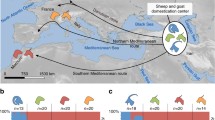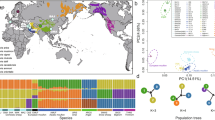Abstract
The sheep is one of the most successful and widely spread domestic animals. Archaeological evidence traces the first domestic sheep back to the Near East region around 9,000 years ago. It is also known that soon after, the domesticated sheep started to flow out of the centre of origin and spread all over the ancient world following the expansion of agriculture. Throughout time, herders, nature elements and eventually some hybridization with different wild relatives produced a multitude of breeds. However, until the advent of the molecular genetics field, very little was known about the origins of most of those breeds. Two decades after the first genetic studies, we have gathered considerable information on the origins, phylogenetic relationships and patterns of genetic diversity of the sheep across the world. Indeed, the genetic studies confirmed the Near East region as the main centre of origin and also revealed other contributions from other regions. Specifically about the fat-tailed sheep, molecular genetics was also able to link their maternal origin to a specific group. So far, modern sheep have originated from five different maternal origins. Nonetheless, the technological advances of the DNA sequencing techniques are bringing more data that is showing the complexity of the domestication process.


Similar content being viewed by others
References
Barthelme, J. W., 1985. Fisher-hunters and neolithic pastoralists in East Turkana, Kenya, (British Archaeological Reports, Oxford)
Bruford, M. W. and Townsend, S. J., 2006. Mitochondrial DNA diversity in modern sheep. In: M. A. Zeder, et al. (eds), Documenting domestication: new genetic and archaeological paradigms, (University of California Press, Berkeley), 306–316
Chen, S.-Y., Duanb, Z.-Y., Shaa, T., Xiangyub, J., Wub, S.-F. and Zhang, Y.-P., 2006. Origin, genetic diversity, and population structure of Chinese domestic sheep, Gene, 376, 216–223
Chessa, B., Pereira, F. and Arnaud, F., 2009. Revealing the history of sheep domestication using retrovirus integrations, Science, 324, 532–536
Clutton Brock, J. and Uerpmann, H.-P., 1974. The sheep of early Jericho, Journal ofArchaeological Science, 1, 261–274
Clutton-Brock, J., 1993. The spread of domestic animals in Africa. In: T. Shaw, et al. (eds), The Archaeology of Africa: Food, Metals and Towns, (Routledge, New York), 61–70
Clutton-Brock, J., 1999. A Natural History of Domesticated Mammals, (Cambridge University Press, Cambridge)
Davis, S. J. M. and Beckett, J. V., 1999. Animal husbandry and agricultural improvement: The archaeological evidence from animal bones and teeth, rural history, 10, 1–17
Epstein, H., 1971. The origin of the domestic animals of Africa, (Africana Publishing Corporation, New York)
Epstein, H., 1985. The Awassi sheep with special reference to the improved dairy type, (FAO, Rome)
Festa-Bianchet, M., 2000. A summary of discussion on the taxonomy of mountain ungulates and its conservation implications, Workshop on Caprinae taxonomy (Ankara, Turkey)
Goodall, E., 1946. Domestic animals in rock art, Transactions of the Rhodesia Scientific Association, 41, 57–62
Guo, J., Du, L. X., Ma, Y. H., Guan, W. J., Li, H. B., Zhao, Q. J., Li, X. and Rao, S. Q., 2005. A novel maternal lineage revealed in sheep (Ovis aries), Animal Genetics, 36, 331–336
Hellborg, L. and Ellegren, H., 2004. Low levels of nucleotide diversity in mammalian Y chromosomes, Molecular Biology and Evolution, 21, 158–163
Henshilwood, C., 1996. A revised chronology for pastoralism in southernmost Africa: new evidence of sheep at c. 2000 b.p. from Blombos Cave, South Africa, Antiquity, 70, 945–949
Hiendleder, S., Mainz, K., Plante, Y. and Lewalski, H., 1998. Analysis of mitochondrial DNA indicates that domestic sheep are derived from two different ancestral maternal sources: no evidence for contributions from urial and argali sheep, Journal of Heredity, 89, 113–120
Hiendleder, S., Kaupe, B., Wassmuth, R. and Janke, A., 2002. Molecular analysis of wild and domestic sheep questions current nomenclature and provides evidence for domestication from two different subspecies, Proceedings of the Royal Society B: Biological Sciences, 269, 893–904
Horsburgh, K. A. and Rhines, A., 2010. Genetic characterization of an archaeological sheep assemblage from South Africa's Western Cape, Journal of Archaeological Science, 37, 2906–2910
Jerardino, A., 1999. A first account of fat-tailed sheep in the rock paintings of the Western Cape coast, South African Archaeological Bulletin, 54, 64–66
Kijas, J., Townley, D. and Dalrymple, B., 2009. A genome wide survey of SNP variation reveals the genetic structure of sheep breeds, PloS one, 4, e4668
Lawson, L. J. and Hewitt, G. M., 2002. Comparison of substitution rates in ZFX and ZFY introns of sheep and goat related species supports the hypothesis of male-biased mutation rates, Journal of Molecular Evolution, 54, 54–61
Legge, T., 1996. The beginnings of caprine domestication. In: D. R. Harris (eds), The Origins and Spread of Agriculture and Pastoralism in Eurasia, (Smithsonian Institution Press, New York), 238–262
Maddox, J. F., Davies, K. P. and Crawford, A. M., 2001. An enhanced linkage map of the sheep genome comprising more than 1000 loci, Genome Research, 11, 1275–1289
Manhire, A. H., Parkington, J. E. and Robey, T. S., 1984. Stone tools and Sandveld settlement. In: M. Hall, et al. (eds), Frontiers: Southern African Archaeology Today, (BAR International Series, Cambridge), 111–120
Manhire, A. H., Parkington, J. E., Mazel, A. D. and Maggs, T. M. O. C., 1986. Cattle, sheep and horses: a review of domestic animals in the rock art of southern Africa, South African Archaeological Bulletin (Goodwin Series), 5, 22–30
Marshall, F., 1994. Archaeological Perspectives on East African pastoralism. In: E. Fratkin, et al. (eds), African Pastoralist Systems: An Integrated Approach, (Lynne Rienner Publishers, Boulder, CO), 17–43
Marshall, F., 2000. The origins and spread of domestic animals in East Africa. In: R. M. Blench and MacDonald, K. C. (eds), The origin and development of African livestock, (University College Press., London), 191–221
Meadows, J. R. S., Hawken, R. J. and Kijas, J. W., 2004. Nucleotide diversity on the ovine Y chromosome, Animal Genetics, 35, 379–385
Meadows, J. R. S., Hanotte, O., Drögemüller, C., Calvo, J., Godfrey, R., Coltman, D., Maddox, J. F., Marzanov, N., Kantanen, J. and Kijas, J. W., 2006. Globally dispersed Y chromosomal haplotypes in wild and domestic sheep, Animal Genetics, 37, 444–453
Meadows, J. R. S., Cemal, I., Karaca, O., Gootwine, E. and Kijas, J. W., 2007. Five ovine mitochondrial lineages identified from sheep breeds of the near east, Genetics, 175, 1371–1379
Meadows, J. R. S., Hiendleder, S. and Kijas, J. W., 2011. Haplogroup relationships between domestic and wild sheep resolved using a mitogenome panel, Heredity, 06:700-706. doi:10.1038/hdy.2010.122.
Oner, Y., Calvo, J. H. and Elmaci, C., 2010. Y chromosomal characterization of Turkish native sheep breeds, Livestock Science, doi:10.1016/j.livsci.2010.08.015
Payen, E., Pailhoux, E., Abou Merhi, R., Gianquinto, L., Kirszenbaum, M., Locatelli, A. and Cotinot, C., 1996. Characterization of ovine SRY transcript and developmental expression of genes involved in sexual differentiation, International Journal of Developmental Biology, 40, 567–575
Pedrosa, S., Uzun, M., Arranz, J.-J., Gutiérrez-Gil, B., San Primitivo, F. and Bayón, Y., 2005. Evidence of three maternal lineages in near eastern sheep supporting multiple domestication events, Proceedings of the Royal Society of London B, 272, 2211–2217
Pereira, F., Davis, S. J. M., Pereira, L., McEvoy, B., Bradley, D. G. and Amorim, A., 2006. Genetic signatures of a Mediterranean influence in Iberian Peninsula sheep husbandry, Molecular Biology and Evolution, 23, 1420–1426
Peter, C., Bruford, M. and Perez, T., 2007. Genetic diversity and subdivision of 57 European and Middle-Eastern sheep breeds, Animal Genetics, 38, 37–44
Phillipson, D. W., 1977. The Later Prehistory of Eastern and Southern Africa, (Heinemann, London)
Rezaei, H. R., Naderi, S., Chintauan-Marquier, I. C., Taberlet, P., Virk, A. T., Naghash, H. R., Rioux, D., Kaboli, M. and Pompanon, F., 2010. Evolution and taxonomy of the wild species of the genus Ovis (Mammalia, Artiodactyla, Bovidae), Molecular Phylogenetics and Evolution, 54, 315–326
Robertshaw, P. T., 1978. The origin of pastoralism in the Cape, South African Historical Journal, 10, 117–133
Ryder, M., 1991. Domestication, history and breed evolution in sheep, (Elsevier, Amsterdam)
Ryder, M. L., 1983. Sheep and Man, (Duckworth, London)
Ryder, M. L., 1984. Sheep. In: I. L. Mason (eds), Evolution of domesticated animals, (Longman, London), 63–85
Schweitzer, F. R. and Scott, K. J., 1973. Early occurrence of domestic sheep in sub-Saharan Africa, Nature, 241, 547
Sealy, J. and Yates, R., 1994. The chronology of the introduction of pastoralism to the Cape, South Africa, Antiquity, 68, 58–67
Tapio, M., Marzanov, N., Ozerov, M., Ćinkulov, M., Gonzarenko, G., Kiselyova, T., Murawski, M., Viinalass, H. and Kantanen, J., 2006. Sheep Mitochondrial DNA Variation in European, Caucasian, and Central Asian Areas, Molecular Biology and Evolution, 23, 1776–1783
Tapio, M., Ozerov, M., Tapio, I., Toro, M., Marzanov, N., Cinkulov, M., Goncharenko, G., Kiselyova, T., Murawski, M. and Kantanen, J., 2010. Microsatellite-based genetic diversity and population structure of domestic sheep in northern Eurasia, BMC Genetics, 11, 76
Uzun, M., Gutiérrez-Gil, B., Arranz, J.-J., San Primitivo, F., Saatci, M., Kaya, M. and Bayón, Y., 2006. Genetic relationships among Turkish sheep, Genetics, Selection and Evolution, 38, 513–524
Vavilov, N., 1992. Origin and Geography of Cultivated Plants, (Cambridge University Press, Cambridge)
Vinnicombe, P., 1976. People of the Eland: Rock Paintings of the Drakensberg Bushmen as a Reflection of their Life and Thought, (University of Natal Press, Pietermaritzburg, South Africa)
Webley, L., 2001. The re-excavation of Spoegrivier Cave on the west coast of southern Africa, Annals of the Eastern Cape Museums, 2, 19–49
Wood, N. J. and Phua, S. H., 1996. Variation in the control region sequence of the sheep mitochondrial genome, Animal Genetics, 27, 25–33
Zeder, M., Emshwiller, E., Smith, B. D. and Bradley, D. G., 2006. Documenting domestication: the intersection of genetics and agriculture, Trends in Genetics, 22, 139–155
Zeuner, F. E., 1963. A History of Domesticated Animals, (Hutchinson, London)
Acknowledgements
SC is the recipient of a FCT individual fellowship grant SFRH/BPD/46082/2008.
Author information
Authors and Affiliations
Corresponding author
Rights and permissions
About this article
Cite this article
Rocha, J., Chen, S. & Beja-Pereira, A. Molecular evidence for fat-tailed sheep domestication. Trop Anim Health Prod 43, 1237–1243 (2011). https://doi.org/10.1007/s11250-011-9854-9
Accepted:
Published:
Issue Date:
DOI: https://doi.org/10.1007/s11250-011-9854-9




